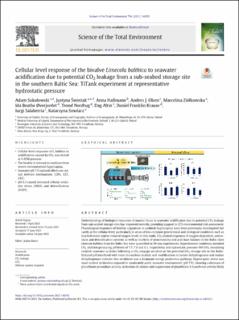| dc.contributor.author | Sokołowski, Adam | |
| dc.contributor.author | Świeżak, Justyna | |
| dc.contributor.author | Hallman, Anna | |
| dc.contributor.author | Olsen, Anders Johny | |
| dc.contributor.author | Ziółkowska, Marcelina | |
| dc.contributor.author | Øverjordet, Ida Beathe | |
| dc.contributor.author | Nordtug, Trond | |
| dc.contributor.author | Altin, Dag | |
| dc.contributor.author | Krause, Daniel Franklin | |
| dc.contributor.author | Salaberria, Iurgi | |
| dc.contributor.author | Smolarz, Katarzyna | |
| dc.date.accessioned | 2021-08-11T10:56:18Z | |
| dc.date.available | 2021-08-11T10:56:18Z | |
| dc.date.created | 2021-08-03T09:44:38Z | |
| dc.date.issued | 2021-11-10 | |
| dc.identifier.citation | Science of the Total Environment. 2021, 794 . | en_US |
| dc.identifier.issn | 0048-9697 | |
| dc.identifier.uri | https://hdl.handle.net/11250/2767356 | |
| dc.description.abstract | Understanding of biological responses of marine fauna to seawater acidification due to potential CO2 leakage from sub-seabed storage sites has improved recently, providing support to CCS environmental risk assessment. Physiological responses of benthic organisms to ambient hypercapnia have been previously investigated but rarely at the cellular level, particularly in areas of less common geochemical and ecological conditions such as brackish water and/or reduced oxygen levels. In this study, CO2-related responses of oxygen-dependent, antioxidant and detoxification systems as well as markers of neurotoxicity and acid-base balance in the Baltic clam Limecola balthica from the Baltic Sea were quantified in 50-day experiments. Experimental conditions included CO2 addition producing pH levels of 7.7, 7.0 and 6.3, respectively and hydrostatic pressure 900 kPa, simulating realistic seawater acidities following a CO2 seepage accident at the potential CO2-storage site in the Baltic. Reduced pH interfered with most biomarkers studied, and modifications to lactate dehydrogenase and malate dehydrogenase indicate that aerobiosis was a dominant energy production pathway. Hypercapnic stress was most evident in bivalves exposed to moderately acidic seawater environment (pH 7.0), showing a decrease of glutathione peroxidase activity, activation of catalase and suppression of glutathione S-transferase activity likely in response to enhanced free radical production. The clams subjected to pH 7.0 also demonstrated acetylcholinesterase activation that might be linked to prolonged impact of contaminants released from sediment. The most acidified conditions (pH 6.3) stimulated glutathione and malondialdehyde concentration in the bivalve tissue suggesting potential cell damage. Temporal variations of most biomarkers imply that after a 10-to-15-day initial phase of an acute disturbance, the metabolic and antioxidant defence systems recovered their capacities. | en_US |
| dc.language.iso | eng | en_US |
| dc.publisher | Elsevier Ltd | en_US |
| dc.rights | Attribution-NonCommercial-NoDerivatives 4.0 Internasjonal | * |
| dc.rights.uri | http://creativecommons.org/licenses/by-nc-nd/4.0/deed.no | * |
| dc.subject | Acidification | en_US |
| dc.subject | CO2 leakage | en_US |
| dc.subject | CCS | en_US |
| dc.subject | Defence system response | en_US |
| dc.subject | Limecola balthica | en_US |
| dc.subject | Representative hydrostatic pressure | en_US |
| dc.title | Cellular level response of the bivalve Limecola balthica to seawater acidification due to potential CO2 leakage from a sub-seabed storage site in the southern Baltic Sea: TiTank experiment at representative hydrostatic pressure | en_US |
| dc.type | Journal article | en_US |
| dc.type | Peer reviewed | en_US |
| dc.description.version | publishedVersion | en_US |
| dc.rights.holder | © 2021 The Authors. Published by Elsevier B.V. | en_US |
| dc.source.pagenumber | 0 | en_US |
| dc.source.volume | 794 | en_US |
| dc.source.journal | Science of the Total Environment | en_US |
| dc.identifier.doi | 10.1016/j.scitotenv.2021.148593 | |
| dc.identifier.cristin | 1923548 | |
| cristin.ispublished | true | |
| cristin.fulltext | original | |
| cristin.qualitycode | 2 | |

